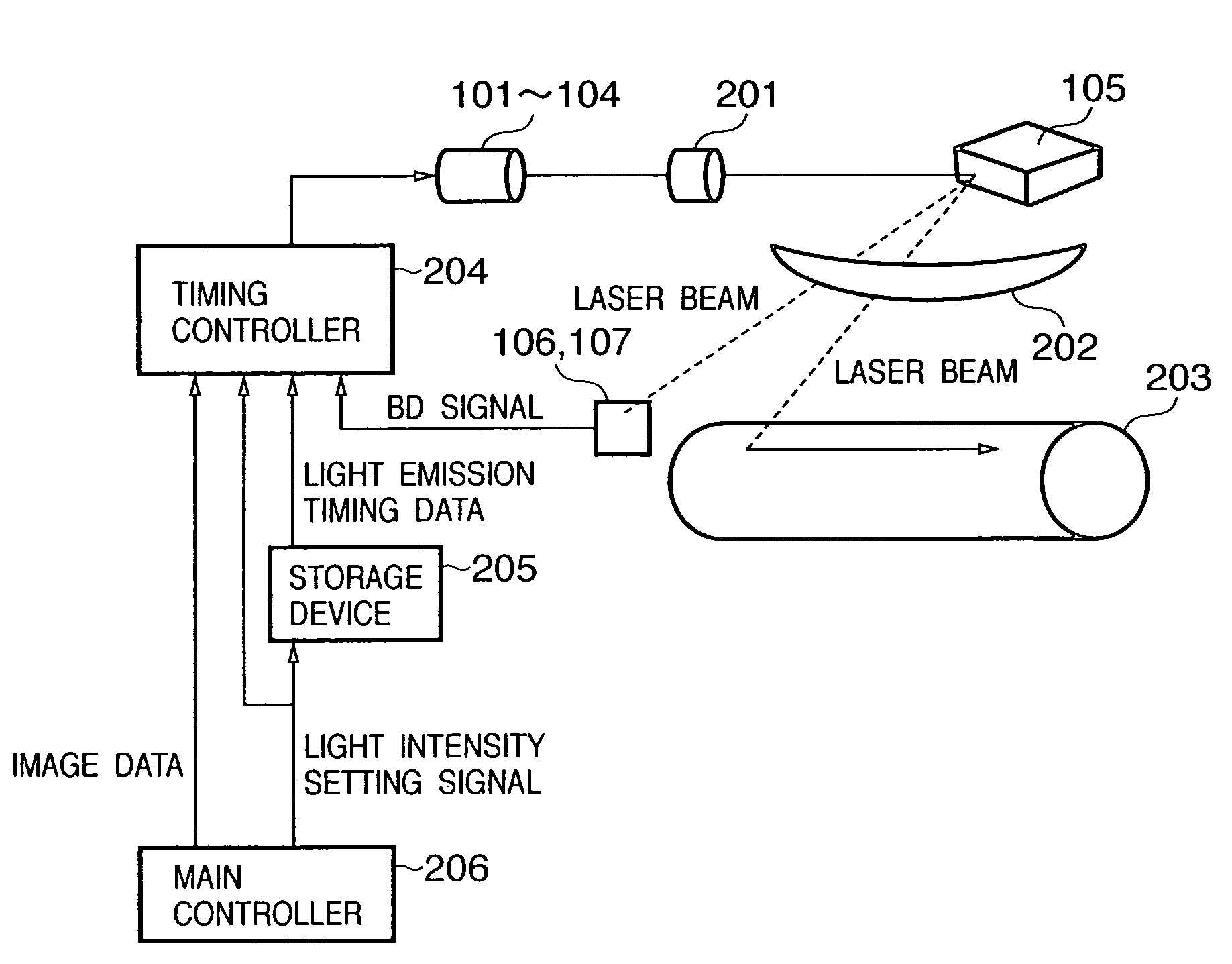Method and apparatus for image forming
a technology of image forming and apparatus, applied in the field of image forming technology, can solve the problems of increasing circuit scale, increasing cost, and reducing the quality of formed images, so as to reduce the shift of position and reduce the cost
- Summary
- Abstract
- Description
- Claims
- Application Information
AI Technical Summary
Benefits of technology
Problems solved by technology
Method used
Image
Examples
first embodiment
[0031]FIG. 1 is a diagram showing an example of an optical scanning apparatus of a color image forming apparatus capable of adapting the invention according to the present embodiment. Laser beams emitted from a yellow image forming semiconductor laser (hereinafter the yellow laser) 101, a magenta image forming semiconductor laser (hereinafter the magenta laser) 102, a cyan image forming semiconductor laser (hereinafter the cyan laser) 103, and a black image forming semiconductor laser (hereinafter the black laser) 104, respectively, are collected into parallel rays by a collimator lens, not shown, and scanned at equal angular speeds upon reflection by a polygon mirror 105 rotating at a constant rpm.
[0032]The laser beams reflected by the polygon mirror 105 pass through an fθ lens, not shown, are reflected by a yellow laser reflecting mirror 111, a magenta laser reflecting mirror 112, a cyan laser reflecting mirror 113 and a black laser reflecting mirror 114, respectively, and directe...
second embodiment
[0051]In the present embodiment, a description is given of an example of the calculation of the preferable light emission timing data at each light intensity.
[0052]FIG. 8 is a diagram showing an example of an image forming apparatus according to the present embodiment. Structures that are identical to those already described are allocated identical reference numerals, and a description thereof is omitted here.
[0053]A printer controller 801 is an image processing apparatus that performs image processing on image data input from an 806 optical sensor controller. Reference numeral 802 is an engine controller, which is a control device that controls an image-forming engine 803 based on image signals output from the printer controller 801. Included in the image-forming engine 803 are the lasers 101-104, the photosensitive drum 203, and, not shown, a fixing apparatus, a recording paper transport mechanism and the like. Included in the engine controller 802 are the above-described timing c...
third embodiment
[0071]In the present embodiment, an example of a specific method for determining the light emission timing is shown. FIG. 13 is a diagram showing an example of a table showing the relation between light intensity settings and light emission timing data according to the present embodiment. The horizontal axis shows the light intensity settings and the vertical axis shows the light emission timing. In the example shown in the diagram, the light emission timing data is set at t1 seconds for light intensity A and at t2 seconds for light intensity B. This light emission timing data t1, t2 indicates the light emission starting time of the laser beams using the respective BD signal pulse rise times as references.
[0072]By referring to the table as described, a unique light emission timing can be determined from a given light intensity. The table can be stored in the storage device 205. The storage device 205 outputs light emission timing data corresponding to the light intensity setting sig...
PUM
 Login to View More
Login to View More Abstract
Description
Claims
Application Information
 Login to View More
Login to View More - R&D
- Intellectual Property
- Life Sciences
- Materials
- Tech Scout
- Unparalleled Data Quality
- Higher Quality Content
- 60% Fewer Hallucinations
Browse by: Latest US Patents, China's latest patents, Technical Efficacy Thesaurus, Application Domain, Technology Topic, Popular Technical Reports.
© 2025 PatSnap. All rights reserved.Legal|Privacy policy|Modern Slavery Act Transparency Statement|Sitemap|About US| Contact US: help@patsnap.com



